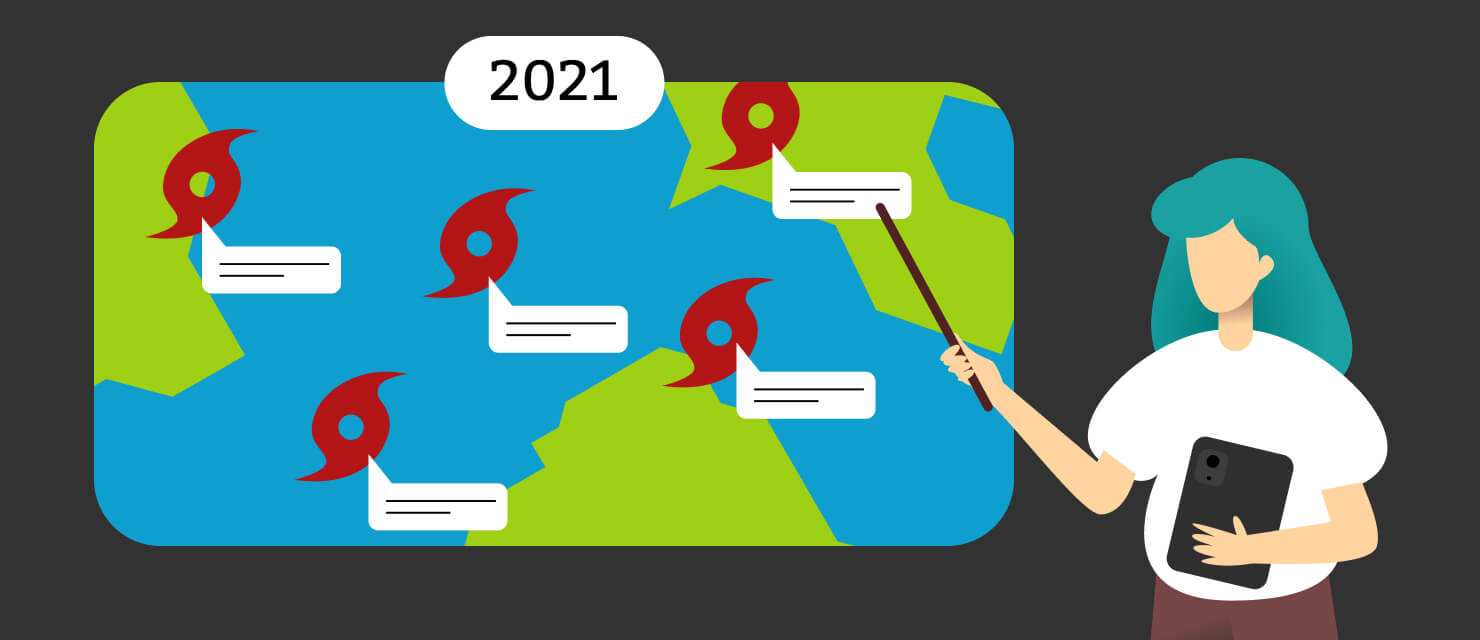ฤดูพายุเฮอริเคนแอตแลนติกปี 2021 มีเหตุการณ์พายุมากมายจนองค์การอุตุนิยมวิทยาโลกหมดชื่อพายุ ในเดือนพฤษภาคม 2021 NOAA คาดการณ์ว่าจะมีพายุที่มีชื่อ 13 ถึง 20 ลูก โดยมีพายุเฮอริเคนใหญ่ 3 ถึง 5 ลูก รวมทั้งหมดมีพายุ 21 ลูกในประเภทต่างๆ ที่พัดผ่านมหาสมุทรแอตแลนติก ทำให้ปี 2021 เป็นปีที่ทำลายสถิติ มีพายุเฮอริเคนมากกว่าในปี 2005 (27 ลูก) และในปี 2020 (30 ลูก)
นอกจากนี้ยังเป็นฤดูพายุเฮอริเคนที่มีค่าใช้จ่ายสูงที่สุด ทำให้เกิดความเสียหายมูลค่า 67 พันล้านดอลลาร์ มีพายุเฮอริเคน 8 ลูกที่ขึ้นฝั่งในปี 2021 และ 3 ในจำนวนนั้นทำให้ประเทศที่ได้รับผลกระทบเสียหายหลายพันล้านดอลลาร์
ตอนนี้มาดูกันว่าพายุใดบ้างที่เขย่าทวีปในปี 2021
พายุเฮอริเคนใหญ่ในปี 2021
เริ่มต้นด้วยพายุเฮอริเคนที่ทำลายล้างและใหญ่ที่สุดที่พัดถล่มสหรัฐอเมริกาและประเทศเพื่อนบ้านในปี 2021
พายุเฮอริเคนไอด้า

ที่มาของภาพ: Wikipedia
พายุเฮอริเคนไอด้าเป็นพายุไซโคลนแอตแลนติกระดับ 4 ที่พัดถล่มทางตะวันออกเฉียงใต้ของสหรัฐอเมริกาในเดือนสิงหาคมและกันยายน 2021 ผลกระทบของพายุยังขยายไปถึงภาคตะวันออกเฉียงเหนือของประเทศ มีผู้เสียชีวิตอย่างน้อย 115 คนจากภัยธรรมชาตินี้ มันเป็นพายุเฮอริเคนที่เลวร้ายที่สุดในฤดูพายุปี 2021

ผลกระทบของไอด้าในเกาะแกรนด์, หลุยเซียนา ที่มาของภาพ: CNBC
ถูกติดตามครั้งแรกโดยศูนย์พายุเฮอริเคนแห่งชาติเมื่อวันที่ 23 สิงหาคม ไอด้ากลายเป็นพายุเฮอริเคนระดับ 1 เมื่อวันที่ 27 สิงหาคม 2021 ในวันที่ 29 สิงหาคม ไซโคลนได้ยกระดับเป็นระดับ 4 การโจมตีที่รุนแรงที่สุดของไอด้าต่อเมืองนิวออร์ลีนส์ (หลุยเซียนา) เกิดขึ้นเวลา 19:00 น. ตามเวลาท้องถิ่น ลมแรงที่มีความเร็วประมาณ 155 ไมล์ต่อชั่วโมงพัดเข้าชายฝั่งหลุยเซียนา ทำให้เกิดน้ำท่วมในพื้นที่ชายฝั่ง อย่างไรก็ตาม เมื่อไอด้ามาถึงทวีป มันก็ลดลงทันทีเป็นระดับ 2 ซากของพายุเฮอริเคนได้ไปถึงภาคตะวันออกเฉียงเหนือของประเทศ โดยเฉพาะอย่างยิ่งมีน้ำท่วมหนักในนิวยอร์ก
กว่า 70% ของหลุยเซียนาไม่มีไฟฟ้าใช้ บ้านมากกว่าล้านหลังถูกทิ้งไว้โดยไม่มีไฟฟ้า ภัยธรรมชาติทำให้แม่น้ำมิสซิสซิปปีเปลี่ยนทิศทาง มันคร่าชีวิตผู้คนไป 115 คน ทำลายบ้านเรือน 1,200 หลัง และก่อให้เกิดความเสียหายมูลค่าอย่างน้อย 75 พันล้านดอลลาร์ โดยมีการสูญเสียที่ประกันไว้ 40 ล้านดอลลาร์
และนี่คือภาพการตกของฝนที่เกิดจากไอด้าใน RainViewer: https://twitter.com/i/status/1432073750103609353
พายุเฮอริเคนนิโคลัส

ที่มาของภาพ: TheAustinMan, CC BY-SA 4.0, ผ่าน Wikimedia Commons
ก่อตัวเมื่อวันที่ 12 กันยายนในอ่าวเม็กซิโก เพียงไม่กี่สัปดาห์หลังจากไอด้า พายุโซนร้อนนิโคลัสได้ทวีความรุนแรงขึ้นเป็นพายุเฮอริเคนระดับ 1 เมื่อวันที่ 13 กันยายน พายุพัดถล่มเท็กซัสและภาคใต้ของหลุยเซียนา ตามรายงานของศูนย์พายุเฮอริเคนแห่งชาติของสหรัฐอเมริกา ความเร็วลมสูงสุดในศูนย์กลางของมันถึง 76 ไมล์ต่อชั่วโมง นิโคลัสเคลื่อนที่ไปทางตะวันออกเฉียงเหนือที่ความเร็ว 10 ไมล์ต่อชั่วโมง ทำให้เกิดไฟฟ้าดับครั้งใหญ่ นอกจากนี้ยังนำฝนตกหนักและน้ำท่วม นิโคลัสไม่ได้คร่าชีวิตใคร แต่ทำให้ประเทศเสียหายประมาณ 2 พันล้านดอลลาร์
นี่คือแผนที่ของปริมาณน้ำฝนที่เกิดจากนิโคลัส:
![]()
พายุโซนร้อนเฟร็ด

ที่มาของภาพ: Wikipedia
พายุนี้พัดถล่มทางใต้ของสาธารณรัฐโดมินิกันและชายฝั่งทางเหนือของคิวบาเมื่อวันที่ 9 สิงหาคม เมื่อมาถึงฟลอริดาเมื่อวันที่ 16 สิงหาคม พายุได้เคลื่อนตัวไปทางเหนือและทำให้เกิดพายุทอร์นาโดในจอร์เจีย นอร์ทแคโรไลนา เซาท์แคโรไลนา และเพนซิลเวเนีย นอกจากนี้ยังทำให้ไฟฟ้าดับในบ้านประมาณ 75,000 หลังตามเส้นทางของมันและก่อให้เกิดความเสียหายทางการเงิน 1.3 พันล้านดอลลาร์

น้ำท่วมที่เกิดจากเฟร็ดในสาธารณรัฐโดมินิกัน ที่มาของภาพ: Reuters
พายุเฮอริเคนเอลซ่า

ที่มาของภาพ: Wikipedia
เอลซ่าเป็นพายุเฮอริเคนลูกแรกของฤดูพายุเฮอริเคนแอตแลนติกปี 2021 และเป็นพายุที่มีชื่อที่ห้าเร็วที่สุด เริ่มต้นเมื่อวันที่ 1 กรกฎาคมในฐานะพายุโซนร้อน เอลซ่าได้ยกระดับเป็นพายุเฮอริเคนเมื่อวันที่ 3 กรกฎาคมและนำสภาพพายุเฮอริเคนไปยังเซนต์ลูเซีย เซนต์วินเซนต์ และเกาะอื่นๆ อย่างไรก็ตาม ในวันเดียวกัน เมื่อเคลื่อนตัวผ่านทะเลแคริบเบียน มันสูญเสียความแข็งแกร่งและกลายเป็นพายุโซนร้อนอีกครั้ง เมื่อวันที่ 5 กรกฎาคม พายุเฮอริเคนเอลซ่าขึ้นฝั่งในคิวบา ซึ่งมีการอพยพคน 180,000 คน เมื่อวันที่ 6 กรกฎาคม มันเข้าถึงฟลอริดา สร้างสภาพพายุโซนร้อนในฟลอริดาคีย์ เคลื่อนตัวต่อไปตามชายฝั่งอ่าว และขึ้นฝั่งในฟลอริดาตอนเหนือในวันถัดไป จากนั้นเส้นทางของพายุรวมถึงจอร์เจียและชายฝั่งแอตแลนติกก่อนที่มันจะสลายตัวในมหาสมุทรแอตแลนติกเหนือ เอลซ่ารับผิดชอบต่อการเสียชีวิต 13 ราย
ลูกศรทิศทางของเอลซ่าในแอป RainViewer:

พายุเฮอริเคนแซม

ที่มาของภาพ: Wikipedia
พายุนี้เป็นผลมาจากคลื่นโซนร้อนจากชายฝั่งตะวันตกของแอฟริกา มันเป็นพายุเฮอริเคนใหญ่ลูกที่สี่และพายุที่มีชื่อที่ 18 นอกจากนี้ยังเป็นพายุเฮอริเคนที่ยาวนานที่สุดในฤดูนี้ เนื่องจากเกิดขึ้นระหว่างปลายเดือนกันยายนถึงต้นเดือนตุลาคม
เดิมเป็นพายุดีเปรสชันโซนร้อน แซมเปลี่ยนเป็นพายุเฮอริเคนเมื่อวันที่ 24 กันยายนและได้รับระดับ 4 เมื่อวันที่ 25 กันยายน มันแสดงความเร็วลม 145 ไมล์ต่อชั่วโมง ห่างจากเบอร์มิวดา 550 ไมล์ทางตะวันออกเฉียงใต้ แซมเคลื่อนตัวไปทางตะวันตกเฉียงเหนือที่ความเร็ว 16 ไมล์ต่อชั่วโมง ที่จุดสูงสุด พายุขึ้นฝั่งในคิวบาตะวันออก แซมทำให้เกิดฝนตกหนักในเปอร์โตริโก แต่ไม่มีความเสียหายหรือการเสียชีวิต
นี่คือเส้นทางของแซมในแอป RainViewer:

พายุเฮอริเคนเกรซ

พายุเฮอริเคนเกรซเกิดขึ้นครั้งแรกในฐานะพายุโซนร้อนเหนือเฮติ จากนั้นมันกลับไปยังทะเลแคริบเบียน กลายเป็นพายุเฮอริเคน และขึ้นฝั่งในคาบสมุทรยูกาตันในเม็กซิโกตะวันออกเฉียงใต้เมื่อวันที่ 19 สิงหาคม เป็นผลให้มีคนประมาณ 150,000 คนไม่มีไฟฟ้าใช้ การดับไฟฟ้ายังทำให้น้ำประปาหยุดชะงัก สนามบินนานาชาติแคนคูนยกเลิกเที่ยวบินหลายเที่ยวบิน ในวันเสาร์ที่ 21 สิงหาคม NHC รายงานว่าความแรงของพายุเฮอริเคนเพิ่มขึ้นเป็นระดับ 3 ใกล้เม็กซิโก เกรซคร่าชีวิตผู้คนไป 8 คน
พายุโซนร้อนโคลเด็ตต์

เริ่มต้นในหลุยเซียนาในฐานะพายุดีเปรสชันโซนร้อนเมื่อวันที่ 19 มิถุนายน โคลเด็ตต์ยกระดับเป็นพายุโซนร้อนในนิวออร์ลีนส์ ก่อให้เกิดความเสียหายมากที่สุดทางตะวันออกของเมือง พายุทำให้เกิดน้ำท่วมและพายุทอร์นาโดในฟลอริดาและแอละแบมา จำนวนผู้เสียชีวิตคือ 13 คน เช่นเดียวกับเอลซ่า 10 คนในจำนวนนั้นเป็นเด็ก
พายุเฮอริเคนแลร์รี่

พัดถล่มจังหวัดนิวฟันด์แลนด์ในแคนาดาเมื่อวันที่ 10 กันยายนในฐานะพายุเฮอริเคนระดับ 1 แลร์รี่ทำให้เกิดไฟฟ้าดับในบ้าน 60,000 หลัง นอกจากนี้ยังทำให้เกิดความเสียหายต่อไม้ แต่โชคดีที่ไม่มีชีวิตสูญเสีย ซากของแลร์รี่เคลื่อนตัวไปทางเหนือ ทำให้เกิดหิมะตกหนักบนชายฝั่งกรีนแลนด์
ฤดูพายุเฮอริเคนปี 2021: พายุเล็กน้อย
ฤดูพายุเฮอริเคนแอตแลนติกปี 2021 ยังรวมถึงพายุ 13 ลูกที่จัดเป็นพายุเล็กน้อย ในจำนวนนั้นคือ:
พายุเฮอริเคนเฮนรี
เฮนรี “เกิด” ทางตะวันออกเฉียงเหนือของเบอร์มิวดาและเปลี่ยนเป็นพายุดีเปรสชันโซนร้อนเมื่อวันที่ 16 สิงหาคม หนึ่งวันต่อมา มันยกระดับเป็นพายุโซนร้อน หลังจากนั้นมันได้ทวีความรุนแรงเป็นพายุเฮอริเคนระดับ 1 อ่อนลงกลับเป็นพายุโซนร้อน และขึ้นฝั่งที่โรดไอแลนด์เมื่อวันที่ 22 สิงหาคม เฮนรีทำให้เกิดฝนตกหนักและน้ำท่วมในนิวอิงแลนด์และภาคตะวันออกเฉียงเหนือของสหรัฐอเมริกา พัดถล่มเมืองใหญ่ของบอสตันและนิวยอร์ก และคร่าชีวิตผู้คนไปสองคน
จากเหตุการณ์สภาพอากาศนี้ บ้านและอพาร์ตเมนต์ส่วนใหญ่ - เกือบ 70,000 หลัง - ยังคงไม่มีไฟฟ้าใช้ในรัฐโรดไอแลนด์ รัฐนี้เป็นรัฐแรกในเส้นทางของพายุโซนร้อน ในรัฐคอนเนตทิคัตที่อยู่ใกล้เคียง บ้าน 27.4 พันหลังไม่มีไฟฟ้าใช้
พายุโซนร้อนมินดี้
มินดี้ก่อตัวนอกชายฝั่งฟลอริดาเมื่อวันที่ 8 กันยายน ส่งผลกระทบต่อภาคตะวันออกเฉียงใต้ของสหรัฐอเมริกาและส่วนใหญ่ของเม็กซิโก เช่นเดียวกับแซม มันเกิดจากคลื่นโซนร้อนจากชายฝั่งตะวันตกของแอฟริกา เมื่อวันที่ 9 กันยายน มันขึ้นฝั่งที่เกาะเซนต์วินเซนต์ ระหว่างการเคลื่อนตัวข้ามเม็กซิโก พายุโซนร้อนทำให้เกิดน้ำท่วมใหญ่ ก่อให้เกิดความสูญเสีย 75 ล้านดอลลาร์และคร่าชีวิตผู้คนไป 23 คน เมื่อวันที่ 10 กันยายน มินดี้กลายเป็นพายุไซโคลนโซนร้อนหลัง
พายุโซนร้อนโอเด็ตต์
ต่างจากพายุส่วนใหญ่ในฤดูพายุเฮอริเคนแอตแลนติกปี 2021 พายุโซนร้อนโอเด็ตต์เกิดขึ้นในเดือนธันวาคมแม้ว่าฤดูจะสิ้นสุดในวันที่ 30 พฤศจิกายน โอเด็ตต์ก่อตัวเมื่อวันที่ 3 ธันวาคมในฐานะพายุดีเปรสชันโซนร้อนใกล้จาเมกา โอเด็ตต์ขึ้นฝั่งในสาธารณรัฐโดมินิกัน ทำให้เกิดน้ำท่วมและดินถล่ม คร่าชีวิตผู้คนไป 8 คน และบาดเจ็บ 14 คน
พายุโซนร้อนวันด้า
พายุนี้พัดถล่มชายฝั่งตะวันออกของสหรัฐอเมริกาในช่วงต้นเดือนพฤศจิกายน 2021 มันทำให้เกิดน้ำท่วมใหญ่ในพื้นที่ที่เคยถูกพัดถล่มโดยไอด้าและเฮนรีมาก่อน ในรัฐแมสซาชูเซตส์ วันด้าทำให้บ้านประมาณ 500,000 หลังไม่มีไฟฟ้าใช้
พายุเล็กน้อยอื่นๆ ที่เกิดขึ้นในมหาสมุทรแอตแลนติกในปี 2021 ได้แก่ พายุโซนร้อนวิกเตอร์ โรส ปีเตอร์ มินดี้ เคท จูเลียน แดนนี่ บิลล์ อนา และพายุโซนร้อนเทเรซา
ฤดูพายุเฮอริเคนแอตแลนติกปี 2021: สรุป
ตอนนี้มาสรุปฤดูพายุเฮอริเคนแอตแลนติกอย่างเป็นทางการและเน้นข้อเท็จจริงสำคัญเกี่ยวกับมัน
- ในปี 2021 มีพายุเฮอริเคนเจ็ดลูกพัดผ่านทวีป
- มีพายุที่มีชื่อ 21 ลูกและพายุเฮอริเคนใหญ่สี่ลูก
- มีการทวีความรุนแรงอย่างรวดเร็วของพายุเฮอริเคนห้าลูก – ไอด้า เกรซ เอลซ่า แลร์รี่ และแซม
- พายุเฮอริเคนแปดลูกพัดถล่มชายฝั่งของสหรัฐอเมริกา
- ภัยธรรมชาติเหล่านี้ส่วนใหญ่เกิดขึ้นในเดือนกันยายน
ฤดูพายุเฮอริเคนแอตแลนติกปี 2021
| ชื่อ | ระดับสูงสุด | วันที่ | ความเร็วลมสูงสุดที่คงที่ | ความกดอากาศต่ำสุดที่ศูนย์กลาง |
|---|---|---|---|---|
| Ana | TS | 22 - 23 พฤษภาคม | 45 mph | 1006 mb |
| Bill | TS | 14 - 15 มิถุนายน | 60 mph | 998 mb |
| Claudette | TS | 19 - 22 มิถุนายน | 45 mph | 1004 mb |
| Danny | TS | 28 - 29 มิถุนายน | 40 mph | 1011 mb |
| Elsa | 1 | 1 - 9 กรกฎาคม | 85 mph | 991 mb |
| Fred | TS | 11 - 17 สิงหาคม | 65 mph | 993 mb |
| Grace | 3 | 14 - 21 สิงหาคม | 125 mph | 962 mb |
| Henri | 1 | 16 - 22 สิงหาคม | 75 mph | 986 mb |
| Julian | TS | 24 - 29 สิงหาคม | 60 mph | 995 mb |
| Ida | 4 | 26 - 30 สิงหาคม | 150 mph | 929 mb |
| Kate | TS | 30 - 31 สิงหาคม | 45 mph | 1004 mb |
| Larry | 3 | 1 - 11 กันยายน | 125 mph | 955 mb |
| Mindy | TS | 8 - 9 กันยายน | 45 mph | 1004 mb |
| Nicholas | 1 | 12 - 14 กันยายน | 75 mph | 989 mb |
| Odette | TS | 17 - 18 กันยายน | 45 mph | 1001 mb |
| Peter | TS | 19 - 21 กันยายน | 50 mph | 1005 mb |
| Rose | TS | 19 - 22 กันยายน | 50 mph | 1004 mb |
| Sam | 4 | 23 กันยายน - 5 ตุลาคม | 155 mph | 929 mb |
| Teresa | TS | 24 - 25 กันยายน | 45 mph | 1008 mb |
| Victor | TS | 29 กันยายน - 2 ตุลาคม | 65 mph | 997 mb |
| Wanda | TS | 31 ตุลาคม - 7 พฤศจิกายน | 50 mph | 987 mb |
ที่มา: https://www.ncei.noaa.gov/access/monitoring/monthly-report/tropical-cyclones/202113
หากคุณอาศัยอยู่ใกล้พื้นที่ที่ได้รับผลกระทบ เราขอแนะนำให้คุณรับการแจ้งเตือนสภาพอากาศอย่างจริงจังเพื่อให้คุณมีเวลาพอที่จะไปยังที่พักพิงใกล้เคียง แอป RainViewer จะช่วยให้คุณรับรู้ถึงสภาพอากาศที่รุนแรงที่กำลังจะมาถึงด้วยการแจ้งเตือนแบบพุชและ แผนที่ติดตามพายุ คุณจะได้รับการแจ้งเตือนทันทีหลังจากการก่อตัวของพายุโซนร้อนและยังคงอัปเดตเกี่ยวกับเส้นทางและการเปลี่ยนแปลงระดับของมัน ปลอดภัยไว้!






